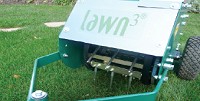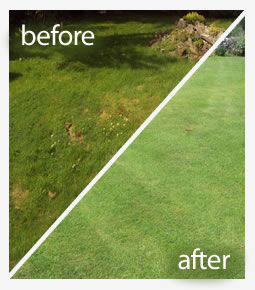Aeration
 Aerating is arguably the most important thing you can do for a lawn other than mow it and there are two ways of aerating a lawn – Solid Tine and Hollow Tine or Plugging.
Aerating is arguably the most important thing you can do for a lawn other than mow it and there are two ways of aerating a lawn – Solid Tine and Hollow Tine or Plugging.
An Aerating machine, which is very heavy, is used to force metal tines or tubes into the soil. It is about the size of a large push type lawn mower.
Solid Tine Aerating
Number of Treatments – Typically 1 per annum, but can be 2 or more by choice.
Timing of Treatments – Best undertaken in Spring or Autumn but available all year round.
Treatment Type – An additional Lawn 3 treatment.
Solid tine aerating is the equivalent of going all over your lawn with a garden fork, pushed into the soil to a depth of between two and four inches. It can be undertaken as often as you wish and is particularly beneficial in the Spring and Autumn.
- It enables oxygen to enter the root-ball and encourages the roots to grow healthily and down the tine holes. A deep healthy root-ball is vital if the grass above ground is going to be lush and healthy.
- Feed is more readily absorbed and taken into the grass structure.
- Natural compaction and settlement is relieved, stimulating healthy growth. Water can more readily soak into the soil helping the lawn retain moisture and to fight the effects of a long dry spell.
- Noxious gasses that may be trapped under the lawn – and which can stunt growth and cause all manner of problems – are released.
- In the autumn aeration assists natural drainage, avoiding waterlogged lawns and consequently helps combat moss colonisation.
- Solid tine aeration is best undertaken in all soil types except very heavy clay where hollow tine aerating is preferable.
Hollow Tine Aerating
Number of Treatments – Once every 3 to 4 years or as appropriate when used in conjunction to solid tine.
Timing of Treatments – Available Spring or Autumn.
Treatment Type – An additional Lawn 3 treatment.
Hollow tine aerating is the equivalent to pushing hollow metal tubes into the ground all over the lawn to a depth of about three inches.
- When the tube is removed a plug of soil and turf is caught in the tube and expelled. Many thousands of two to three inch plugs of turf and soil are removed from the lawn. These plugs must ideally be removed from the lawn. If left they form soil deposits that are ideal growing platforms for weed and moss. Sometimes the punched holes are filled with sand/soil dressing to help restore a tired lawn – an immensely time consuming job.
- When the lawn is very heavily compacted – in high traffic walk-way areas for example – hollow tine aerating greatly reduces the compaction and assists in the restoration of the natural balance in the turf by allowing the soil to “relax”.
- Hollow tines must not be used if dry weather is likely because of the evaporation that occurs from the tined holes and the subsequent lawn dry out.
- Care must be taken to not over aerate using hollow tines because “de-compaction” occurs which can damage the very structure of the lawn making it overly soft underfoot. This typically occurs if lawns are hollow tined “every time”.



